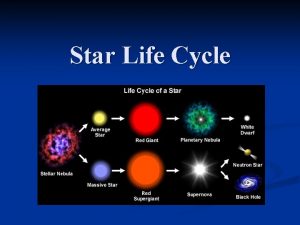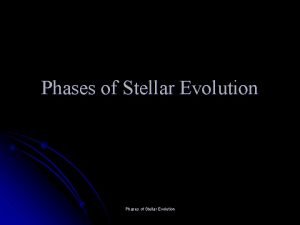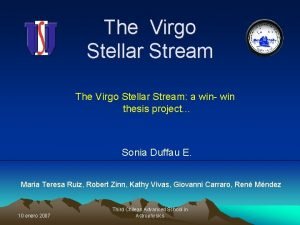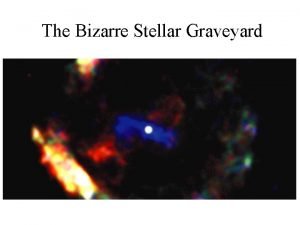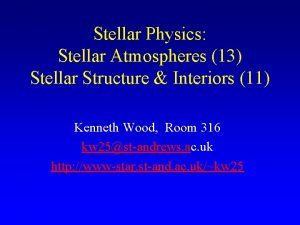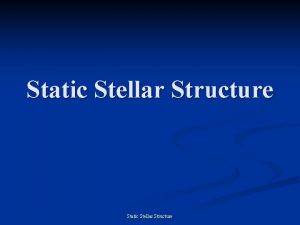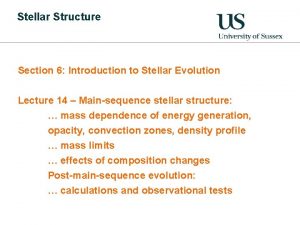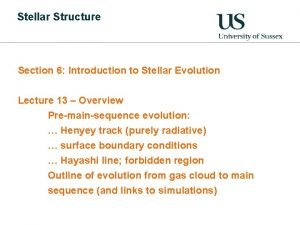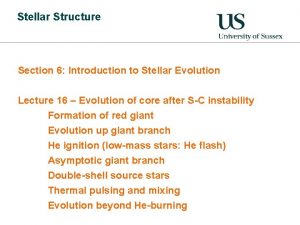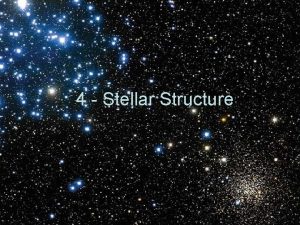Stellar Structure Section 5 The Physics of Stellar








- Slides: 8

Stellar Structure Section 5: The Physics of Stellar Interiors Lecture 12 – Neutrino reactions Solar neutrinos Opacity processes: scattering, bb, bf, ff Rosseland mean opacity Physical sources: … scattering (Thomson) … bound-free and free-free absorption Continuous opacity in cool stars Approximate formulae

Neutrino reactions • H-burning reactions – energy loss by neutrinos small (< 5%) • Later stages of evolution – high density and temperature allow other reactions, leading to much greater energy loss (see blackboard for details): - URCA process - Photo-neutrino process - Pair neutrino process - Bremsstrahlung neutrinos - Plasma neutrinos • Main-sequence stars: neutrino ‘oscillations’ – explain ‘solar neutrino problem’

Opacity • Accurate calculations very complex • Two major recalculations (1990 s): Opacity Project (OP) (UCL) and OPAL (Lawrence Livermore National Lab, California) • In outline – 4 types of process contribute to radiative opacity (see blackboard for details): - Scattering - Bound-bound transitions - Bound-free transitions - Free-free transitions • Other processes (e. g. pair production) may cause absorption under very extreme conditions

Rosseland mean opacity • In stellar structure equations, use the Rosseland mean opacity: (3. 21) (on handout) • This is a harmonic mean – so hard to add new sources of opacity • Also – if opacity unknown in any frequency range, must assume it to be infinite, not zero! • Ideally, need estimate of both absorption and scattering at all frequencies

Scattering • Main processes: - Scattering by free electrons: important in stellar interiors - Rayleigh scattering by atoms or molecules: atmospheres only • Compton scattering by free electrons – scattering with change of frequency (non-coherent or incoherent scattering) (see blackboard) • Non-relativistic limit: Thomson or coherent scattering – change in frequency can be neglected • Cross-section depends inversely on square of particle mass, so only electrons matter; leads (see blackboard) to opacity: = constant = 0. 02(1+X) m 2 kg-1 (5. 47)

Bound-free absorption • Bound-bound absorption only important in outer layers • H, He ~fully ionised in interior, so main contributors are heavier atoms and ions with bound electrons • Absorption is continuous above critical frequency corresponding to ionisation potential, and has simple form with frequency (see blackboard) • Frequency dependence strongly modified in degenerate conditions • Different critical frequency for each bound level • Populations of bound levels given by Boltzmann factor • Total cross-section has series of absorption ‘edges’ under envelope given by Boltzmann factor (Handout 7, top)

Free-free absorption, and continuous absorption in cool stars • Free-free absorption has similar frequency dependence to boundfree absorption (except for ~0), with no critical frequency • Cool stars (3000 -7000 K) show continuous absorption, almost independent of frequency in far-red – doesn’t seem to match • Rupert Wildt (1930 s): negative hydrogen ion (see blackboard) • Continuous absorption dominated by bound-free H- absorption in visual, with H- free-free taking over in near infrared (Handout 7, bottom) • Processes compete with neutral H absorption (Balmer, Paschen, Brackett) • Enough electrons available from metals of low ionisation potential to allow H- absorption to dominate over neutral H absorption

Approximate formulae for opacity • Detailed calculations of opacity: complicated, time-consuming • Realistic stellar models use tables of opacity, computed at points in a grid of density and temperature; the opacity for a particular temperature and density is obtained by interpolation in tables • General behaviour shown in Handout 8 (top figure) • For given density, (T) has 3 branches, ~ straight lines in log-log plot (Handout 8, bottom figure) • Hence 3 approximate formulae (~ 3 mechanisms) (see blackboard) • Use values in Handout to estimate mean free path of photon, and hence temperature difference between emission and absorption (see blackboard) – very small! Justifies thermodynamic equilibrium


